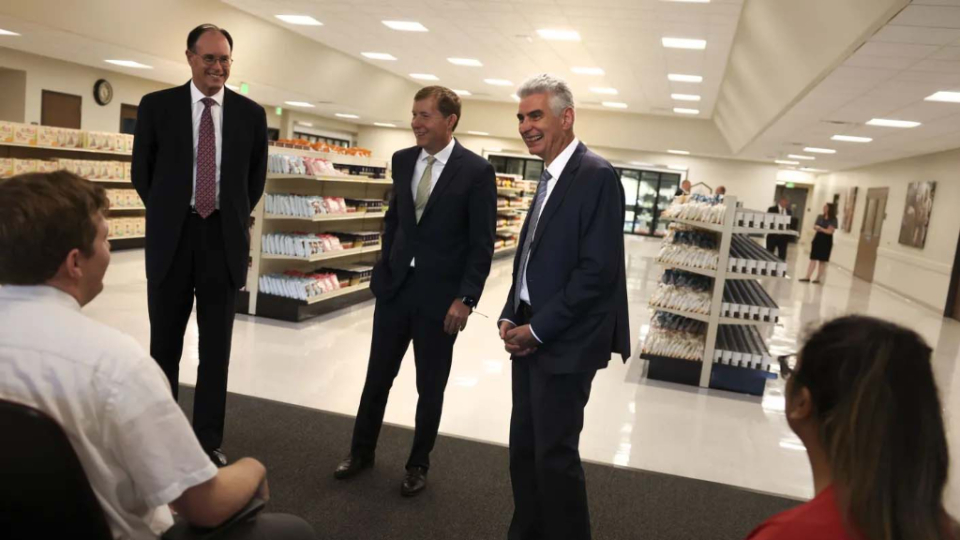
Church-welfare-humanitarian-1
From left, Bishop W. Christopher Waddell, First Counselor; Bishop L. Todd Budge, Second Counselor; and Presiding Bishop Gérald Caussé chat with volunteers and missionaries at the bishops’ storehouse at Welfare Square in Salt Lake City, Utah, on Wednesday, September 7, 2022. Photo by Laura Seitz, courtesy of Church News.Copyright 2022 Deseret News Publishing Company.
This story appears here courtesy of TheChurchNews.com. It is not for use by other media.
By Sydney Walker, Church News
Editor’s note: This part 2 of an Inside Church Headquarters series on the Presiding Bishopric. Read the Introduction: What is the Presiding Bishopric? What do they do? and part 1: Location, Design, Construction of Latter-day Saint Temples.
Walking down aisles of food at the bishops’ storehouse at Welfare Square in Salt Lake City, Utah, the Presiding Bishopric greeted missionaries and volunteers one by one, praising them for keeping the facility clean and organized.
One of those missionaries was Elder Jordan Coulam. It was the 21-year-old’s first day serving at the bishops’ storehouse. Having stocked many of the shelves, Elder Coulam felt grateful the Presiding Bishopric noticed his efforts — and he was quick to acknowledge it wasn’t about him.
“There’s a very strong spirit here,” Elder Coulam told the Church News. From where he stood at the entrance of the storehouse, he pointed out seven images he could see of the Savior ministering to people.
Whether stocking shelves or helping fill orders, “it’s about ministering to the one,” Elder Coulam said.
Presiding Bishop Gérald Caussé said he and his counselors, Bishop W. Christopher Waddell and Bishop L. Todd Budge, are humbled by faithful members like Elder Coulam whom they meet throughout the world.
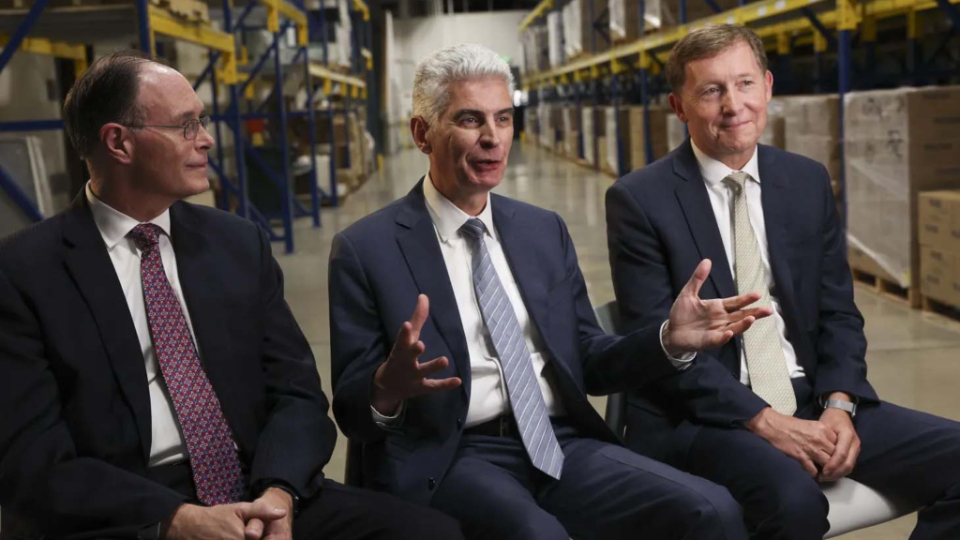
Church-welfare-humanitarian-2
From left, Bishop W. Christopher Waddell, First Counselor; Presiding Bishop Gérald Caussé; and Bishop L. Todd Budge, Second Counselor, are interviewed at the bishops’ storehouse at Welfare Square in Salt Lake City, Utah, on Wednesday, September 7, 2022. Photo by Laura Seitz, courtesy of Church News.Copyright 2022 Deseret News Publishing Company.
“The Church is all about people,” Bishop Caussé said.
As part of the Inside Church Headquarters series, the Presiding Bishopric spoke to the Church News from the bishops’ storehouse at Welfare Square, providing a glimpse into the Church’s vast welfare and humanitarian efforts around the world.
More Than Food
The sights and smells of the bishops’ storehouse remind Bishop Caussé of his career working with supermarket chains and food distribution companies. https://youtu.be/a0sjqCrSMKs
“I’m in many ways doing the same things,” Bishop Caussé said of his role as Presiding Bishop of the Church. “I’m still managing distribution systems, but it’s all different at the same time. It’s still very demanding, challenging in many ways, but it is easier because the Lord helps. It strengthens my testimony that this is the Lord’s work.”
The bishops’ storehouse at Welfare Square is one of 124 bishops’ storehouses in operation worldwide. At bishops’ storehouses, individuals in need work with their local leaders to receive food and other items free of charge.
The Church operates 32 farms, ranches, orchards and processing facilities, which produced over 100 million pounds of food last year, according to the Church’s 2021 annual report. Approximately 36 million pounds were distributed to bishops’ storehouses, while 44 million pounds were donated through community initiatives.
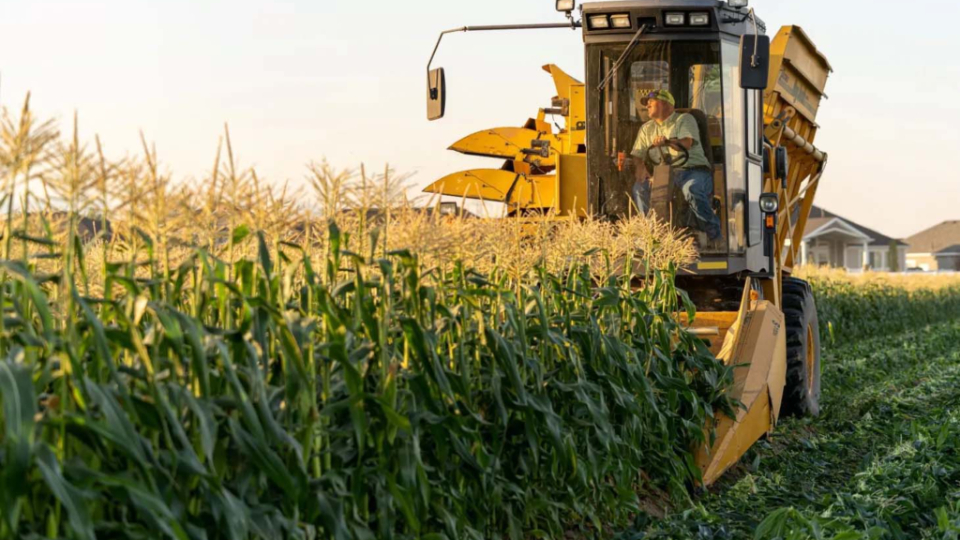
Church-welfare-humanitarian-3
Corn is harvested on a Church farm in Layton, Utah, on Tuesday, August 18, 2020. The corn is canned and sent to the Bishops’ Central Storehouse in Salt Lake City, Utah, for national distribution.2022 by Intellectual Reserve, Inc. All rights reserved.
Food production and distribution is only one part of the Church’s welfare and humanitarian efforts.
In 2021, as stated in its annual report, the Church spent $906 million to help those in need through:
- Fast-offering assistance, which provides temporary financial help to those in need.
- Bishops’ orders for goods, including giving food and commodities from bishops’ storehouses and Deseret Industries stores to those in need.
- Humanitarian projects, including charitable relief in communities across the world.
- Donated commodities, including Church-produced goods provided to communities through food banks and other agencies.
- Donated clothing, including discounted or free apparel given to Deseret Industries.
- Church operations, including family services, counseling, employment centers, farms and food-processing facilities and Deseret Industries stores.
“None of this would happen without the generosity of the members who donate of their money, resources and time,” Bishop Caussé said. “It humbles me to see their examples, and this is happening all around the world.”
Helping others and reaching out to those in need is at the heart of the gospel of Jesus Christ, he said.
“We wouldn’t be the Church of Jesus Christ if we did not follow or strive to follow His example every day. One of the things that He showed us to do is love our neighbor as ourselves. He taught us about the two great commandments, to love God and love our neighbor. These are our brothers and sisters all around the world.”
Bishop Waddell said from emergency response to food security to vision care, “We are there. … The Savior did what He did to bless lives and to set an example for us. He tells us ‘do the things you’ve seen me do.’ And so as a Church, we’re doing what we can to follow His example. The Church strives to bless lives and serve as an example for all of us to reach out and care for those in need.”
The Difference Between Welfare and Humanitarian Aid
Bishop Caussé explained that the Church’s welfare services are generally intended to bless Latter-day Saints in need, while humanitarian aid is typically for all of God’s children. Welfare includes fast offerings, self-reliance services, and food production and distribution. Humanitarian aid includes disaster relief and initiatives for food security and clean water.
Church welfare is designed to be short-term assistance that builds long-term self-reliance. Bishop Waddell said: “Sometimes when people think ‘welfare’ in society, they think ‘handout.’ The Church’s view of welfare is very different. It’s not the hand out, it’s the hand up — it’s trying to lift. … By lifting people, by giving them an opportunity to rise up and overcome the challenges of life, and to gain self-confidence and self-respect, it’s a remarkable thing to see.”
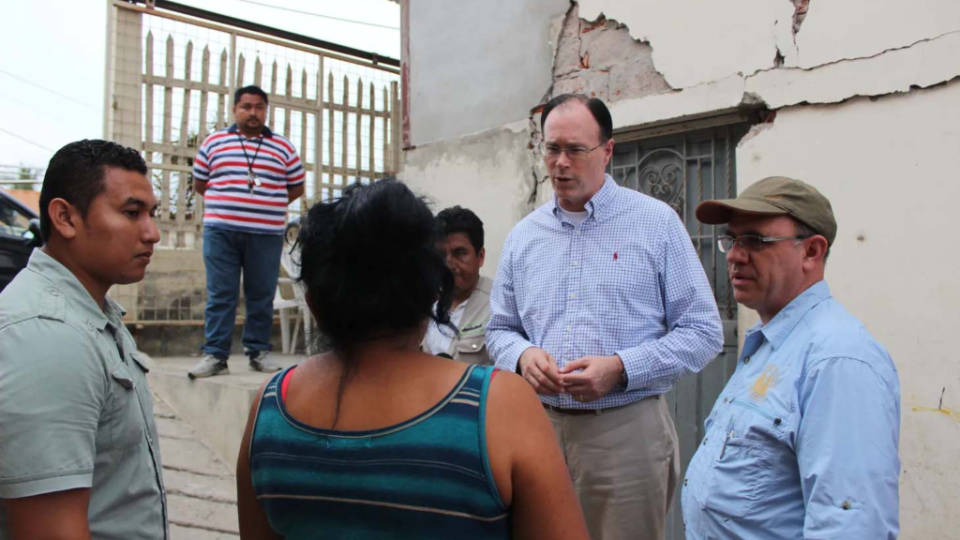
Church-welfare-humanitarian-4
Bishop W. Christopher Waddell, First Counselor in the Presiding Bishopric, visits with people in Ecuador in May 2016 after a devastating earthquake on April 16, 2016.2022 by Intellectual Reserve, Inc. All rights reserved.
Though welfare and humanitarian efforts can be viewed separately, Bishop Budge said, there isn’t a clear line dividing them. For example, some of the humanitarian work the Church does helps members living within the areas where aid is provided. Fueled in part by humanitarian donations, “the welfare system and the humanitarian system bless everyone,” he said.
Church members have the opportunity to fast for a 24-hour period each month and donate a generous fast offering, which is the value of the meals missed or more. The Lord trusts bishops to administer these resources to bless people in need in their ward boundaries. Surplus is sent to the stake and then to the Church to be used for needs wherever they exist.
The law of the fast, Bishop Caussé said, “is really the core of every welfare system in the Church. … This is something that is unifying members of the Church throughout the world.”
Building Self-Reliance
A year after Typhoon Haiyan — one of the most powerful tropical cyclones ever recorded — devastated the Philippines in 2013, Bishop Caussé visited the city of Tacloban.
The Church had provided materials after the storm to help Filipinos rebuild their homes. While rebuilding, many learned skills such as carpentry, plumbing and construction management.
A newly called counselor in the Presiding Bishopric at the time, Bishop Caussé visited a vocational school in Tacloban and saw firsthand the impact of the Church’s aid. “We had hundreds, literally hundreds, of our members receiving vocational training to acquire job skills to find a job or develop their own businesses,” he said. “This is what welfare is.”

Church-welfare-humanitarian-5
The view of the City of Tacloban, Philippines, from Calvary Hill. Adobe Stock Photo.All rights reserved.
In October 2021 general conference, President Russell M. Nelson announced a temple would be constructed in Tacloban.
“Just think of everything that happened in the past few years, and how the welfare system of the Church and the principles of welfare have helped people get ready for a temple to be built,” Bishop Caussé said.
Each humanitarian project the Church is involved in has a goal of self-reliance, he said. “For us, self-reliance is a principle of salvation. It’s a spiritual principle. Every time we ask the question: ‘How are we helping people help themselves?’”
Expansion of the Church’s Humanitarian Efforts
In September, the Church made two multimillion-dollar donations to humanitarian organizations to help care for those in need.
The $32 million donation to the United Nations World Food Programme marked the Church’s largest one-time contribution to a humanitarian organization to date. The donation — presented by Bishop Budge in Rome, Italy, on September 14 — will help provide food and critical assistance to 1.6 million people facing food crises in nine countries.
On September 21, the Church announced a $5 million donation to UNICEF to help fight global malnutrition among children under age 5 in up to 24 countries.
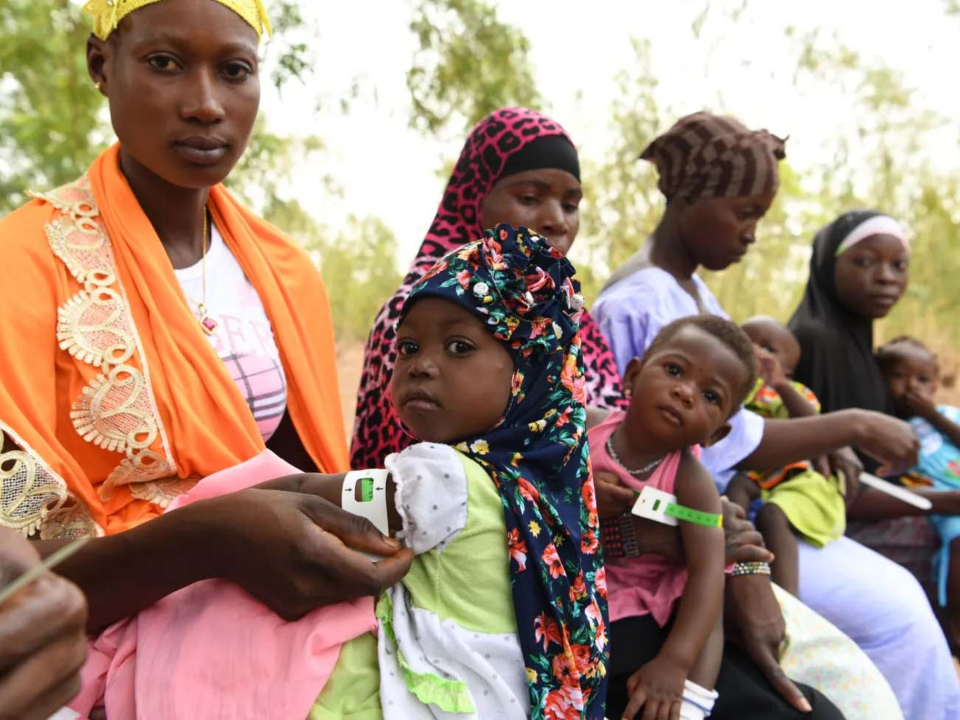
Church-welfare-humanitarian-6
Women and children at a malnutrition screening session in the village of Ngolo in the Northern region of Burkina Faso. Mothers learn how to measure their children and receive a demonstration of preparing enriched porridge.UNICEF/UN0640839/Dejongh
President Dallin H. Oaks, First Counselor in the First Presidency, said in his October 2022 general conference address: “The Church of Jesus Christ is committed to serving those in need, and it is also committed to cooperating with others in that effort.”
Since Bishop Caussé was first called to the Presiding Bishopric 10 years ago, the Church’s humanitarian budget has increased tenfold. Bishop Caussé listed two of many ways this dramatic increase was achieved: collaboration with organizations and planning with Church areas.
“We want to reach out to the most vulnerable populations, people that really are in need anywhere in the world, regardless of their nationalities, their race or their faith,” Bishop Caussé said. “It’s important to be in every place where there is a great need. There are countries where we don’t have a lot of members, yet we are there, working in collaboration with humanitarian organizations to help the people. …
“We have developed relationships with a network of organizations, good organizations that we can trust in every part of the world. And so this enables us to reach a higher scale.”
Such relationships are being established by local areas. “This work is not directed from Salt Lake City,” Bishop Caussé continued. “We have in every area of the Church teams that work under the direction of the Area Presidencies and have developed those local relationships.”
Bishop Waddell noted that each of the Church’s 23 geographic areas has a five-year humanitarian plan based on needs in that part of the world. “Then we work together to meet the needs that are real, everywhere in the world,” he said.
With 8 billion people on earth, the Church’s membership of nearly 17 million is relatively small. “By working with others, we’re able to expand our reach, we’re able to get to places that we wouldn’t be able to get to otherwise,” Bishop Waddell said. “It really multiplies in many ways what we can do.”
The Church’s humanitarian efforts in 2021 included 3,909 projects in 188 countries and territories — the most projects and the most countries to date. In 2020 the Church and its members participated in 3,611 projects in 160 countries and territories; and in 2019, 3,221 projects in 142 countries and territories.
The COVID-19 pandemic provided an opportunity to build relationships with organizations the Church hadn’t worked with before, particularly in Africa and Asia, Bishop Caussé added. “This is creating foundations that we believe are going to help us expand our reach in the future,” he said.
Across Christianity and other faiths, Bishop Budge noted, “There’s a common sense of love and desire to reach out and bless others.” By collaborating with other organizations, “we find common ground with others.”
Blessing the Givers and Receivers
Another way the Church is expanding its reach is through the time, talents and service that individual members provide throughout the world, Bishop Budge said.
In 2021 Latter-day Saints contributed 6.8 million hours of volunteer work. More than 21,500 new community projects were facilitated using JustServe, a Church-sponsored program that matches volunteers with organizations in need.
“A scripture in the Doctrine and Covenants teaches that ‘men should be anxiously engaged in a good cause and do many things of their own free will,’” Bishop Budge said, quoting Doctrine and Covenants 58:27. “I believe our members live that principle. They engage in good causes all over the world of their own free will and choice.”
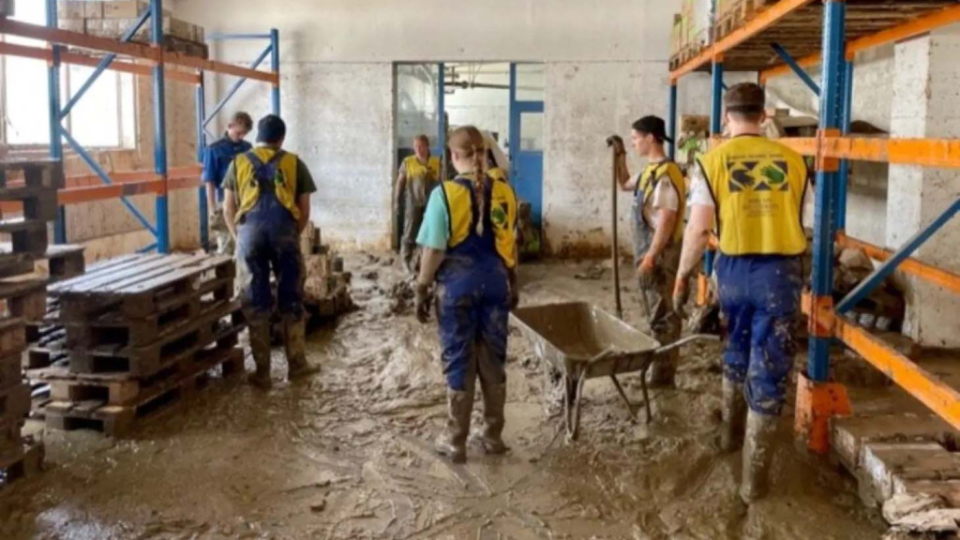
Church-welfare-humanitarian-8
Church volunteers, including members and missionaries, help those affected by the July 2021 floods in Germany.2022 by Intellectual Reserve, Inc. All rights reserved.
Bishop Caussé said the Church wants to bless both the givers and the receivers by providing opportunities for members to participate in projects.
“It’s not about sending a check; it’s much more than this,” Bishop Caussé said. “It’s about our members getting involved and supporting. Practicing our religion involves helping others. …
“I think a big part of what the Church does is provide opportunities for its members to live the gospel. This is one of the ways that we can involve members in following the example of the Savior.”
More About the Presiding Bishopric Series
This Inside Church Headquarters series features the Presiding Bishopric, who work under the direction of the First Presidency to oversee the temporal affairs of the Church. The series includes:
- Introduction: What is the Presiding Bishopric? What do they do?
- Part 1: The location, design and construction of Latter-day Saint temples
- Today — Part 2: A glimpse into the Church’s vast humanitarian and welfare efforts
Copyright 2022 Deseret News Publishing Company.